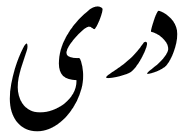Language/Dari/Grammar/Questions
Hi Dari learners! 😊
In this lesson, we will be exploring questions in Dari. Asking questions is an essential part of communication, and it is essential to know how to form questions correctly to be able to fully understand Dari.
Don't hesitate to look into these other pages after completing this lesson: Dari Grammar: Past Tense, Gender, Future Tense & Pronouns.
Forming Yes/No Questions[edit | edit source]
Yes/no questions in Dari can be formed in a straightforward manner. Simply place the verb at the beginning of the sentence, preceding the subject, and the sentence ends with a question mark. For example:
| Dari | Pronunciation | English |
|---|---|---|
| آیا تو داری خوردن؟ | āyā tō dārī khōrdan? | Are you eating? |
| آیا او کتاب میخواند؟ | āyā ū kitāb mīxwānd? | Is he/she reading a book? |
As you can see from the examples above, the word "آیا" (āyā) indicates that the statement is a question. This word can be translated as "is" or "are" depending on the context of the sentence.
Forming Information Questions[edit | edit source]
Information questions in Dari require the use of question words. These words are placed at the beginning of a sentence, and the verb follows the subject. Here are some question words you can use to form information questions:
| Dari | Pronunciation | English |
|---|---|---|
| چرا؟ | chera? | Why? |
| چگونه؟ | chēgunē? | How? |
| کی؟ | kī? | When? |
| من چه؟ | man chē? | What? (general) |
| چند؟ | chand? | How many? |
| کجا؟ | kojā? | Where? |
| کدام؟ | kodām? | Which? |
For example:
- Person 1: تو چه کار میکنی؟ (tō chē kār mīkunī?) (What do you do?)
- Person 2: من دانشجو هستم. (man dāneshjū hastam.) (I am a student.)
Dialogue[edit | edit source]
- Person 1: آیا تو به مهمانی برای فردا میری؟ (āyā tō bé mehmani barāyé fardā mīrī?) (Are you going to the party tomorrow?)
- Person 2: من نمیدانم، چرا؟ (man nēmidānam, chera?) (I don't know, why?)
- Person 1: چون من فکر میکنم که تو یکی از دعوت شدگان هستی. (chon man fēkr mīkunam kē tō yékī az da'wat shudgān hastī.) (Because I think you are one of the invited guests.)
- Person 2: بله، درست است. (balē, dorost ast.) (Yes, that's right.)
Possessive Questions[edit | edit source]
In Dari, possessive questions can't be formed by adding "-ing" as in English. Instead, you have to use the question word "کی" (kī), meaning "whose." Here are some examples:
| Dari | Pronunciation | English |
|---|---|---|
| کی این کتاب است؟ | kī īn kitāb ast? | Whose book is this? |
| آیا موبایل تو است؟ | āyā moubāyl tō ast? | Is this your phone? |
As you can see from the examples above, "کی" (kī) can be used to ask about possession.
Conclusion[edit | edit source]
Congratulations! You have learned how to form different types of questions in Dari. Keep practicing and don't forget to use Find native speakers and ask them any questions you may have. Remember, practice makes perfect!
Don't forget to check out our other Dari lessons, including Grammar and more. To improve your Dari skills further, you can also use the Polyglot Club website.
Sources[edit | edit source]
Now that you've completed this lesson, don't stop learning! Check out these related topics: Resources, Asking Questions & Conjunctions.
Other Lessons[edit | edit source]
- How to Use Be
- Negation
- Conditional Mood
- How to Use Have
- Give your Opinion
- Plurals
- Adjectives
- Pronouns
- Nouns

